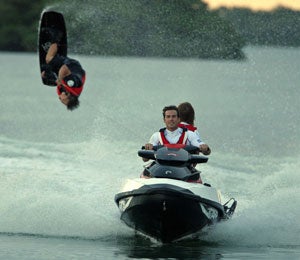Sea-Doo Teams Up With Nike 6.0 Wakeskate Team
Cutting-edge wakeskaters showcase advantages of PWC
It wasn’t all that many years ago that the tie-in between personal watercraft and the professional wakeboard crowd seemed a bit forced. After all, one of the primary goals of wakeboarding is big air, something a PWC’s relatively puny wakes did little to provide.
But as the accompanying video attests, that all changed with the explosion in popularity of sliders, rails, and other obstacles. Suddenly a PWC’s small size, agile maneuverability, and yes, small wakes worked to a rider’s advantage. PWC could get in close to obstacles without battering them with wakes like a full-size towboat. PWC also opened the doors for many more riders to get involved – prices were a bargain compared to a full-size boat, operation was simple, and filling the tank didn’t require half a week’s pay.
Perhaps no group embraced the craft more than wakeskaters, guys who prefer not to be strapped to their board, but instead bring the elements of skateboarding to the water. Like wakeboarding before it, wakeskating has experienced a rapid growth in popularity. And once again, a PWC has proven to be a rider’s all-purpose, inexpensive vehicle of choice.

In fact, Sea-Doo recently teamed with members of the Nike 6.0 wakeskate team to push the wakeskate/PWC connection even further. Led by team members Matt Manzari, Nick Taylor, and Ben Horan, Sea-Doo has put together a series of videos — available on YouTube — to not only show the merits of PWC, but also give fledgling riders some valuable instruction on how to perform the most popular tricks.
Looking to trick your own PWC out to make it more of a wake-inspired machine? If you’re looking for a new vehicle, Sea-Doo has done the work for you. The company’s WAKE Series models feature retractable tow pylons, board racks, and now, even innovative speed control features to get your rider up and out of the water smoothly, then hold that desired speed without the fluctuation common to most driver’s attempts at throttle control. There’s even an available ballast system that can fill with water and weigh the craft down by as much as an additional 200 pounds. Yes, it produces a bigger wake, but in my tests I’ve found it does more for the shape and firmness of the wake itself, providing a better platform from which to launch tricks.
Older ‘Doos can upgrade to many of the WAKE’s options. Accessories are available through Sea-Doo dealers for that brand’s models. Owners of other craft will have a tougher time, but older pylon options can often be found on sites like eBay or Craigslist.
Related Reading
2009 Sea-Doo Wake 155/Wake Pro 215 Review
Get PersonalWatercraft.com in your Inbox!
Like PersonalWatercraft.com on Facebook
Comments
Most Popular

2025 Yamaha JetBlaster PRO 2-Up Review

2024 Kawasaki Jet Ski STX 160X Review

Remembering the Sea-Doo XP

Whatever Happened to the Wetbike?

2025 Yamaha JetBlaster Review










 Your Privacy Choices
Your Privacy Choices